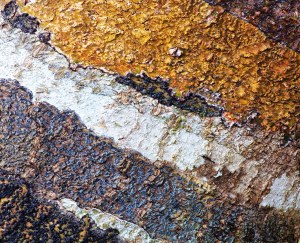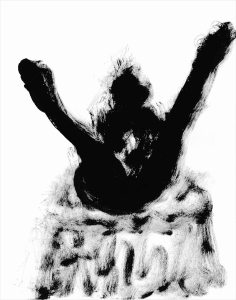 Richard Stone is a visual artist, photographer, storyteller, and writer of both fiction and non-fiction. His creative career also includes working with IDEAS, a former division of Disney, as their StoryAnalytics Master. His work spans many media, from works on paper to acrylic on canvas to macro-photography. His writing includes a focus on storytelling, a children’s novel, and he is currently working on a new screenplay entitled “The Maggid.”
Richard Stone is a visual artist, photographer, storyteller, and writer of both fiction and non-fiction. His creative career also includes working with IDEAS, a former division of Disney, as their StoryAnalytics Master. His work spans many media, from works on paper to acrylic on canvas to macro-photography. His writing includes a focus on storytelling, a children’s novel, and he is currently working on a new screenplay entitled “The Maggid.”
Your bio mentions that you work in 4 medium(s). Can you tell me more about how you create your art?
For the past 4 years, I have focused on macro photography of trees’ bark. I do all of my composition in the camera, rarely cropping images after they are taken, shooting RAW. Processing the images is fairly straightforward. I start out in Adobe Lightroom and do some simple adjustments to the image adjusting the exposure if needed. I then use the NIK software suite to do some sharpening, and some minor improvement of the color saturation.
 My preference is to print these images large—4’ x 5’ or even larger. There is something very exciting to see what was a 2” x 2” section of a tree enlarged to those sizes—very abstract.
My preference is to print these images large—4’ x 5’ or even larger. There is something very exciting to see what was a 2” x 2” section of a tree enlarged to those sizes—very abstract.
In the past I have done a great deal of work using oil pastels on paper—building up images with multiple layers and then using tools to scrape into the surface to reveal earlier layers.
Have also done a great deal of brush and ink drawings—mostly abstract figurative. I’ve extended this approach by using brushes like brooms to paint abstractly on large sheets of paper, then have selectively have torn or cut out sections of the paper, cut the same shapes out of a piece of black foam core, and then married that with another image on the backside of the foam core creating an interesting effect dimensionally.
 Finally, have done a number of large works on canvas depicting leaves. The method—lay the canvas on the floor, and then using ketchup bottles filled with house paint (preferably semi-gloss). I compose by squeezing the paint onto the canvas.
Finally, have done a number of large works on canvas depicting leaves. The method—lay the canvas on the floor, and then using ketchup bottles filled with house paint (preferably semi-gloss). I compose by squeezing the paint onto the canvas.
At what point in your life did you start thinking of yourself as an artist?
In my early 20s. I dropped out of graduate school in psychology after I had completed my master’s degree and took myself off to the Art Institute of Chicago.
How would you describe your spirituality?
Probably more Buddhist at moment, but still am engaged with Judaism—more through its storytelling tradition.
How does your spirituality find expression in your art?
For me, the process of photographing a tree is a profound experience that brings me deeply into communion with this other being, joyfully becoming a witness to its beauty.
Can you share a story of how creating your art expanded your awareness of God?
Martin Buber talks about 2 kinds of relationships we can have with the world. I-It in which the world has utilitarian value for us; and I-Thou, in which we meet the other as a sacred being and as it is. For me this is what photographing trees does for me. And every encounter in this way is for me a profound experience of the mystery of this life.
How do you connect with divine flow when you are creating? Is it an intentional process that you can duplicate?
 Attending to small details often is what takes me into this kind of flow. It’s just about attention outside of myself.
Attending to small details often is what takes me into this kind of flow. It’s just about attention outside of myself.
How do you connect differently to your creative source when you work solo versus when you are collaborating with others?
I have collaborated for years on a host of creative projects as a writer, having written a screenplay and a sitcom with some friends. The collaborative process proved to be great fun, and a profound act of letting go of any attachment to anything. If one of us didn’t like something the other came up with it was immediately dropped until we could find something that we all could agree was funny—produced a better script I think.
In contrast I’m working on a screenplay right now solo—I think not until I get some others to read it will I know whether I hit the mark or need to go back to the drawing board.
Little things often set them off. I was driving one day and stopped at a light and there was a big clump of pampas grass in the median. I immediately imagined that it was the hair of a creature whose head was just under the surface. That led me to imagine that all the trees are actually the tops of the heads of large creatures that became known as Treemungermen—the key characters in an eco-spiritual children’s novel entitled The Kingdom of Nowt.
How do you decide which ideas to pursue?
If it’s something that I become somewhat obsessed about and think about all the time, then I pursue it.
If you were going to teach your creative process to someone else, what would be one or two of the key things you would share?
Find your own voice—and I mean that for writing as well as the visual arts. And lead with your heart not your head. Things that are intellectually interesting but lacking heart rarely reach an aesthetic threshold in my book, and don’t move people.
Thanks Richard!
See his photos at www.richardstonephoto.com. Richard’s books The Healing Art of Storytelling, Stories: The Family Legacy, The Kingdom of Nowt, and The Patient Survival Handbook (co-authored with Stephen Powell) can all be purchased on Amazon. His board game Pitch-A-Story can be purchased at www.pitchastory.com.
If you would like to be a featured artist on Art as Worship, email me at vlowry (@) gmail.com. While I’m no longer recording new episodes for the Art as Worship radio show, I’ll continue to feature artists using their written words to describe the connection between their art and their spirituality. Access the Art as Worship radio interviews on Empower Radio. Listen to an encore presentation of an artist’s interview each Wednesday at 9am Eastern on Empower Radio. Like us on Facebook at Art as Worship, then share your art and comments. Namaste!

